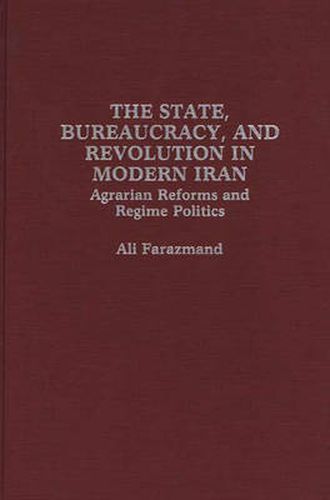Readings Newsletter
Become a Readings Member to make your shopping experience even easier.
Sign in or sign up for free!
You’re not far away from qualifying for FREE standard shipping within Australia
You’ve qualified for FREE standard shipping within Australia
The cart is loading…






Covering the period from 1950 through 1988 this book examines the role of a large bureaucracy under the Shah and post-revolutionary changes in that bureaucracy under the Islamic Republic. It focuses on the role of one of the most powerful bureaucracies in Iran, the Ministry of Agriculture and Rural Development (MARD). The author explains how the MARD transformed rural Iran from a feudalistic social system to a capitalistic system of economy. It helped maintain and enhance the Pahlavi regime under the Shah by developing and guarding capitalism in rural Iran. These two objectives were achieved through rural bureaucratization and extension of the State’s control to the remotest areas of Iran. The author also discusses the impact of the Revolution of 1978-79 on Iranian bureaucracy. Iran has been one of the oldest historical bureaucratic empires the world has ever known. During the Pahlavi regime, bureaucracy was the main instrument of policy formulation and ligitimation. This book fills many of the gaps in our present knowledge of Iranian bureaucracy, particularly in relation to agrarian reform and regime politics. Ali Farazman has based his study on primary data including 150 interviews, the examination of numerous government documents, and, as a former Iranian administrator, direct observations. MARD was chosen as this book’s focus for several reasons. It was central to the Shah’s regime during the 1960s-1970s. Until the 1960s three quarters of Iran’s population lived in rural areas under a feudal system. During this period MARD grew at an unprecedented rate. Through land reform it created a new class of allies for the Shah. It was instrumental in the destruction of Iran’s agriculture, making it dependent on foreign imports. It contributed nine million rural migrants to the cities ultimately fueling the Revolution of 1978-79. The author has chosen MARD as representative of a power Iranian bureaucracy.
$9.00 standard shipping within Australia
FREE standard shipping within Australia for orders over $100.00
Express & International shipping calculated at checkout
Covering the period from 1950 through 1988 this book examines the role of a large bureaucracy under the Shah and post-revolutionary changes in that bureaucracy under the Islamic Republic. It focuses on the role of one of the most powerful bureaucracies in Iran, the Ministry of Agriculture and Rural Development (MARD). The author explains how the MARD transformed rural Iran from a feudalistic social system to a capitalistic system of economy. It helped maintain and enhance the Pahlavi regime under the Shah by developing and guarding capitalism in rural Iran. These two objectives were achieved through rural bureaucratization and extension of the State’s control to the remotest areas of Iran. The author also discusses the impact of the Revolution of 1978-79 on Iranian bureaucracy. Iran has been one of the oldest historical bureaucratic empires the world has ever known. During the Pahlavi regime, bureaucracy was the main instrument of policy formulation and ligitimation. This book fills many of the gaps in our present knowledge of Iranian bureaucracy, particularly in relation to agrarian reform and regime politics. Ali Farazman has based his study on primary data including 150 interviews, the examination of numerous government documents, and, as a former Iranian administrator, direct observations. MARD was chosen as this book’s focus for several reasons. It was central to the Shah’s regime during the 1960s-1970s. Until the 1960s three quarters of Iran’s population lived in rural areas under a feudal system. During this period MARD grew at an unprecedented rate. Through land reform it created a new class of allies for the Shah. It was instrumental in the destruction of Iran’s agriculture, making it dependent on foreign imports. It contributed nine million rural migrants to the cities ultimately fueling the Revolution of 1978-79. The author has chosen MARD as representative of a power Iranian bureaucracy.